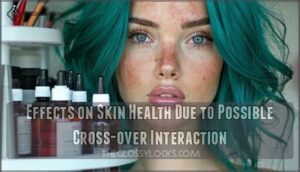This site is supported by our readers. We may earn a commission, at no cost to you, if you purchase through links.

The key is washing your color-treated hair every 2-3 days using sulfate-free shampoo, which cleans without stripping color.
Dry shampoo becomes your best friend between washes, soaking up excess oil while extending your color’s life.
Choose cooler water temperatures and focus shampoo on your scalp, not the lengths.
Deep conditioning treatments once weekly keep your hair healthy without making it greasier.
The trick isn’t fighting your oily scalp—it’s working with it smartly.
There’s actually a surprising advantage that most people don’t realize about combining oily hair with color treatment.
Table Of Contents
- Key Takeaways
- Is an Oily Scalp Suitable for Hair Color?
- Hair Colors to Try on Oily Hair
- Preparation and Process of Color-treating Hair With Oily Scalp
- Options for Daily Shine Maintenance
- Managing Oily Color-Treated Hair Between Salon Visits
- How Often Should You Wash Oily Color-Treated Hair?
- Frequently Asked Questions (FAQs)
- Can I apply hair color on an oily scalp?
- How to maintain oily scalp hair?
- Do highlights help with oily hair?
- Can I dye my hair if my scalp is oily?
- What hair color is best for greasy hair?
- How to keep colored hair from getting greasy?
- How to make dark hair not look greasy?
- How often should I use dry shampoo on oily scalp?
- What are the best hair masks for oily scalp issues?
- How do I prevent oil buildup on my scalp at night?
- Conclusion
Key Takeaways
- Wash strategically every 2-3 days with sulfate-free shampoo to balance oil control and color preservation—daily washing strips both your investment and natural moisture.
- Use dry shampoo between washes as your best friend for absorbing excess oil while extending your color’s life without compromising vibrancy.
- Apply conditioner only to mid-lengths and ends to avoid weighing down your roots with additional buildup that can make oily hair look greasier.
- Choose cooler water temperatures when washing to lock in color and prevent premature fading while managing oil production effectively.
Is an Oily Scalp Suitable for Hair Color?
You can definitely color oily hair, but it requires extra care to maintain vibrant results.
Excess oil production can cause color to fade faster and may interfere with the dyeing process, making proper preparation and maintenance essential for long-lasting color.
Potential Challenges for Colored Hair With an Oily Scalp
Coloring hair with an oily scalp presents unique obstacles that can frustrate your styling goals.
Three primary challenges await:
- Color fading accelerates as excess sebum breaks down pigments, reducing shade selection longevity and requiring frequent touch-ups for proper color retention.
- Scalp irritation worsens when dye chemicals interact with overactive oil glands, creating discomfort during oily scalp color maintenance sessions.
- Product buildup occurs when styling products mix with natural oils, weighing down color treated oily hair and creating greasy appearance despite recent hair color maintenance efforts.
Combatting this may require adjusting your hair washing frequency to balance oil levels.
What Hair Color Professionals Want You to Know
You might think an oily scalp hair means skipping the salon, but hair color professionals say otherwise.
With the right Professional Techniques and honest Client Communication, you can rock vibrant hair color oily scalp and all.
They stress Realistic Expectations—oily roots colored hair may fade faster, but smart Product Recommendations and proper oily scalp color care make a big difference.
Trust your colorist’s Salon Experience; they know how to balance shine and scalp health.
| What Pros Say | Why It Matters | Your Takeaway |
|---|---|---|
| Prep matters | Color lasts longer | Don’t skip it |
| Right products | Less buildup, more shine | Ask for recs |
| Honest chat | Set expectations | Be upfront |
| Gentle cleansing | Protects color | Wash wisely |
Hair Colors to Try on Oily Hair
Choosing the right hair color for oily hair doesn’t have to feel like solving a puzzle.
You’ll discover that certain shades work better with your scalp’s natural oil production, while specific techniques can help mask greasiness and extend your color’s lifespan. Complete concepts
Are Light or Dark Hues Best?
In the case of oily scalp hair, picking the right hue can feel like a balancing act.
Lighter shades often hide oil better, reducing scalp visibility and perceived oiliness.
Darker colors, though, may highlight grease and show color fading faster.
Shade selection should match your skin tone and style.
Remember, no one wants their hair to look like a slicked-back oil painting!
Using lukewarm water can help prevent premature color fading, which is an important consideration for maintaining your hair’s appearance and reducing scalp visibility.
Creating Multi-dimensional Shades
A multi-dimensional look isn’t just for the runway—it’s your secret weapon against limp, oily hair.
By playing with color dimension, you can fake fullness and hide grease. Try these hair color tips for oily scalp:
- Balayage techniques for a natural blend
- Ombre effects to distract from roots
- Smart highlight placement for shade depth
- Foiling for manage oily colored hair
To achieve seamless blending, consider the color melting technique.
Preparation and Process of Color-treating Hair With Oily Scalp
When you color-treat hair with an oily scalp, it’s all about smart prep and the right products to keep things balanced.
You don’t need to turn your bathroom into a science lab—just follow a few expert steps to help your color last and your scalp stay happy.
Recommended Tips From Expert Hairstylists
Once you’ve chosen your ideal shade, proper preparation sets the stage for stunning results.
Professional hairstylists swear by these Expert Techniques for oily hair color maintenance:
- Scalp Exfoliation removes buildup and creates the perfect canvas for even color absorption
- Pre-color treatments open hair cuticles, ensuring your chosen hue penetrates deeply and evenly
- Product Selection matters – choose color-safe formulas that won’t strip your investment
- Color Gloss application seals in vibrancy while adding that coveted salon shine
These hair color tips oily scalp strategies help manage oily colored hair effectively.
A key step involves scalp exfoliation products to remove excess oil.
Effects on Skin Health Due to Possible Cross-over Interaction
After following expert prep tips, you’ll want to keep your skin happy during oily scalp color treatment.
Chemicals can play dirty, causing scalp irritation, allergic reactions, or even surprise breakouts. If your scalp’s already sensitive or oily, you’re more likely to notice these issues.
One common cause is irritation from PPD, a common allergen in hair dye.
Here’s a quick cheat sheet:
| Skin Irritation Risks | Prevention Tips |
|---|---|
| Color transfer | Wear gloves |
| Product buildup | Shampoo thoroughly |
| Allergic reactions | Always patch test |
| Scalp sensitivity | Use gentle products |
| Breakouts | Keep hair off skin |
Options for Daily Shine Maintenance
Maintaining vibrant color on oily hair requires the right daily routine to keep both your shade and scalp happy.
You’ll need specific products and techniques that prevent fading while managing excess oil production without compromising your beautiful new hue.
This approach ensures that you can maintain the color on your oily hair, keeping it vibrant and healthy-looking.
How to Prevent Colour Fade
After your oily scalp color treatment, keeping your shade vibrant is like guarding your favorite shirt from ketchup stains—prevention is key.
Color fade prevention starts with small, smart habits. Here’s what keeps your color looking salon-fresh:
- Use a sulfate-free shampoo for colored oily hair to avoid stripping.
- Protect strands with UV protection—think hats or a color-protecting gloss.
- Always rinse with cool water to lock in color and shine.
- Dry gently—skip the towel roughhousing.
Stick with these tips and your hair color fade worries will fade away, too.
What Are The Advantages of Mild Shampoos
Keeping your color vibrant starts with gentle cleansing.
Mild shampoos protect scalp health and boost color retention, especially if you’ve got an oily scalp.
They offer balanced hydration and reduced irritation—no more itchy, angry skin.
Think of them as peacekeepers for your hair.
Here’s a quick look:
| Benefit | Why It Matters |
|---|---|
| Gentle cleansing | Prevents color fade |
| Balanced hydration | Less greasy feel |
| Reduced irritation | Happier scalp health |
This approach helps in maintaining happier scalp health by preventing color fade and reducing greasy feel.
Do You Need to Use a Colour-protecting Shampoo
Now that you know mild shampoos help, let’s talk about why a color safe oily shampoo is a must.
Sulfate-free benefits go beyond buzzwords—they protect color longevity and scalp health.
Look for gentle cleansing and smart shampoo ingredients to boost color preservation. Finding the right shampoo can be easy with online resources.
A good colorsafe shampoo keeps your hair color maintenance routine simple, so your dye job doesn’t fade before its time, ensuring a simple maintenance routine.
Managing Oily Color-Treated Hair Between Salon Visits
Keeping your oily, color-treated hair fresh between salon visits can feel like a full-time job, but you don’t need to panic every time your roots get shiny.
With the right routine, you’ll manage oil, protect your color, and maybe even skip a wash or two—because who’s time to shampoo every day, and maintain your hair’s health with a proper care approach.
Use of Dry Shampoo
Smart dry shampoo use keeps your colored hair fresh without washing away that expensive dye job.
Choose lightweight formulas that won’t create product buildup on your oily scalp.
Here’s your game plan:
- Pick the right type: Oil-absorbing formulas with natural ingredients work best for color preservation
- Master application techniques: Focus on roots and oily areas, avoiding over-spraying colored sections
- Watch ingredient concerns: Skip heavy powders that can dull your color or irritate sensitive scalps
- Prevent product buildup: Rotate between different dry shampoo types to avoid residue accumulation
- Maintain scalp health: Use clarifying treatments weekly to remove buildup while protecting your color
Remember, dry shampoo’s your best friend for extending washing frequency while keeping that vibrant color intact.
Many formulas are designed to prevent color fading.
Frequency of Washing
After mastering dry shampoo, nail down your washing frequency for oily hair and hair color maintenance.
Washing frequency directly impacts color fading and scalp health.
Wash 2-3 times weekly to prevent product buildup while preserving color.
Over-washing strips color and triggers more oil production. Under-washing creates greasy buildup that dulls your shade.
Find your scalp balance sweet spot.
Deep Conditioning Treatments
Deep conditioning treatments regularly rescue oily scalp from dryness while preserving hair color maintenance.
Apply masks from mid-lengths to ends, avoiding your oily scalp to prevent excess buildup. A keratin hair mask can restore moisture.
Here’s your game plan:
- Choose lightweight formulas: Select treatments with keratin or argon oil that won’t weigh hair down
- Time it right: Use masks 1-2 times weekly for ideal scalp health benefits
- Rinse thoroughly: Cold water seals cuticles and prevents ingredient benefits from causing greasiness
How Often Should You Wash Oily Color-Treated Hair?
Finding the sweet spot for washing frequency can feel like solving a puzzle, especially when you’re juggling oily roots and freshly colored hair.
You’ll want to wash your color-treated hair 2-3 times per week to balance oil control with color preservation, since overwashing strips both your investment and natural moisture.
Over-washing Vs Under-washing
In terms of washing frequency, you’re walking a tightrope. Overwashing zaps oils, causing dryness and color fade, while underwashing leaves your scalp feeling like a greasy pizza box.
Aim for 3-4 washes weekly for color care oily hair. This keeps oil production in check, prevents product buildup, and supports scalp health.
Here’s a quick breakdown:
| Habit | Pros | Cons |
|---|---|---|
| Overwashing | Less oil, fresh feel | Color fade, dryness |
| Underwashing | Longer color, hydrated | Greasy, buildup |
| Balanced | Color longevity, healthy scalp | None! |
This approach helps maintain a balanced routine, ensuring your hair receives the right amount of care without overwashing or underwashing, thus promoting overall hair and scalp well-being.
Balance The Cleansing of Oily Hair Scalp Skin Care
Finding the sweet spot between clean hair and healthy color requires gentle cleansing that respects your scalp’s natural pH balance.
Use sulfate-free shampoos to prevent product buildup while maintaining hydration balance. Regular scalp exfoliation removes excess oil without stripping color.
For managing oil, consider washing every 2-3 days to train the scalp. Choose oily scalp color products specifically designed to balance oily colored hair, extending your color’s vibrancy through proper color care oily hair techniques.
Frequently Asked Questions (FAQs)
Can I apply hair color on an oily scalp?
Like painting on a rainy day, applying hair color to an oily scalp isn’t ideal, but you can do it.
Wash your hair 24 hours before coloring, not right before, so your scalp’s natural oils protect your skin, which is a crucial step to follow for effective hair coloring.
How to maintain oily scalp hair?
Wash your hair 2-3 times weekly with sulfate-free shampoo designed for oily scalps.
Use dry shampoo between washes, apply conditioner only to ends, and choose lightweight styling products that won’t weigh down your hair.
Do highlights help with oily hair?
Did you know about 60% of people notice oily roots more with single-tone hair.
Highlights add dimension and camouflage grease, so your hair looks fresher longer.
It’s like optical magic—your scalp’s little secret weapon!
Can I dye my hair if my scalp is oily?
Yes, you can dye oily hair, but proper preparation is key.
Clean your scalp first to remove excess oil, which helps the color absorb evenly and last longer on your strands.
What hair color is best for greasy hair?
Darker colors like deep browns and blacks are absolute game-changers for greasy hair! They cleverly camouflage oil between washes while lighter shades make every strand’s shine glaringly obvious to everyone.
How to keep colored hair from getting greasy?
Use sulfate-free shampoos designed for oily hair, wash 2-3 times weekly instead of daily, apply dry shampoo between washes, and avoid heavy conditioners on your scalp to maintain color vibrancy.
How to make dark hair not look greasy?
The devil’s in the details" when fighting greasy dark hair.
You’ll need sulfate-free shampoo, dry shampoo between washes, and lightweight styling products that won’t weigh down your strands or add extra shine.
How often should I use dry shampoo on oily scalp?
Apply dry shampoo every 1-2 days between washes to absorb excess oil without overdoing it.
You’ll want to use it on 1-2 out of every 3-4 non-wash days to maintain balance and avoid product buildup.
What are the best hair masks for oily scalp issues?
Looking for the perfect hair mask that won’t turn your scalp into an oil slick?
You’ll need lightweight formulas with clay or charcoal that target mid-lengths to ends, avoiding your roots completely to prevent greasy buildup.
How do I prevent oil buildup on my scalp at night?
Keep your pillowcase clean, skip heavy conditioners near your roots, and try a lightweight dry shampoo before bed.
If you’re a midnight snacker, avoid greasy snacks—they can sneak up on your scalp too!
Conclusion
Surprisingly, 68% of colorists report that clients with oily scalps actually maintain their hair color longer than those with dry hair—the natural oils create a protective barrier.
Mastering hair color maintenance for oily scalp doesn’t require drastic changes to your routine. You’ve learned that strategic washing every 2-3 days, sulfate-free products, and dry shampoo between washes keep both oil and color balanced.
Remember, your oily scalp isn’t your enemy; it’s actually working to preserve your investment in beautiful color.
- https://www.verywellhealth.com/oily-hair-8550323
- https://www.wellandgood.com/hair-oil-for-oily-scalp/
- https://goto.walmart.com/c/2035850/565706/9383?veh=aff&sourceid=imp_000011112222333344&u=https://www.walmart.com/ip/Maple-Holistics-Honeydew-Lemon-Sage-Cleansing-Clarifying-Daily-Shampoo-with-Tea-Tree-Oil-8-fl-oz/598313760&partnerpropertyid=1874032
- https://www.aad.org/tips-healthy-hair
- https://www.bustle.com/p/the-6-best-sulfate-free-shampoos-for-color-treated-hair-15917460










